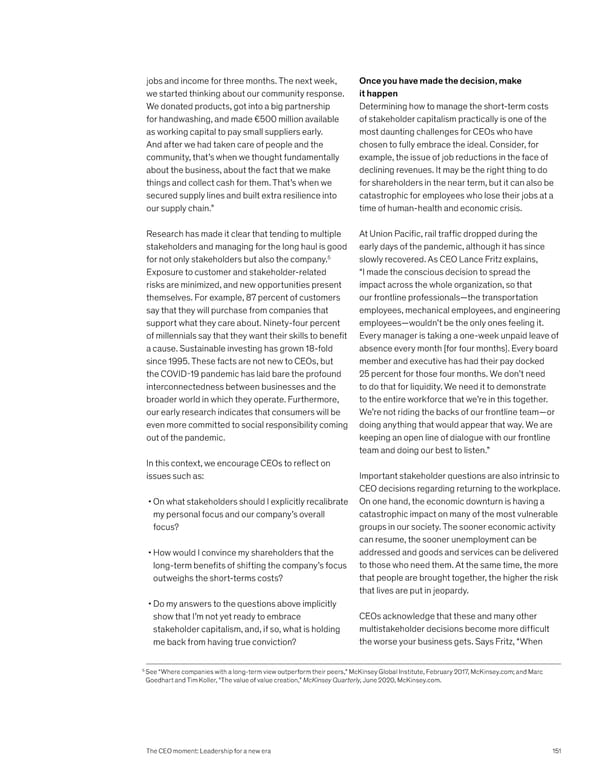jobs and income for three months. The next week, Once you have made the decision, make we started thinking about our community response. it happen We donated products, got into a big partnership Determining how to manage the short-term costs for handwashing, and made €500 million available of stakeholder capitalism practically is one of the as working capital to pay small suppliers early. most daunting challenges for CEOs who have And after we had taken care of people and the chosen to fully embrace the ideal. Consider, for community, that’s when we thought fundamentally example, the issue of job reductions in the face of about the business, about the fact that we make declining revenues. It may be the right thing to do things and collect cash for them. That’s when we for shareholders in the near term, but it can also be secured supply lines and built extra resilience into catastrophic for employees who lose their jobs at a our supply chain.” time of human-health and economic crisis. Research has made it clear that tending to multiple At Union Pacific, rail traffic dropped during the stakeholders and managing for the long haul is good early days of the pandemic, although it has since for not only stakeholders but also the company.5 slowly recovered. As CEO Lance Fritz explains, Exposure to customer and stakeholder-related “I made the conscious decision to spread the risks are minimized, and new opportunities present impact across the whole organization, so that themselves. For example, 87 percent of customers our frontline professionals—the transportation say that they will purchase from companies that employees, mechanical employees, and engineering support what they care about. Ninety-four percent employees—wouldn’t be the only ones feeling it. of millennials say that they want their skills to benefit Every manager is taking a one-week unpaid leave of a cause. Sustainable investing has grown 18-fold absence every month [for four months]. Every board since 1995. These facts are not new to CEOs, but member and executive has had their pay docked the COVID-19 pandemic has laid bare the profound 25 percent for those four months. We don’t need interconnectedness between businesses and the to do that for liquidity. We need it to demonstrate broader world in which they operate. Furthermore, to the entire workforce that we’re in this together. our early research indicates that consumers will be We’re not riding the backs of our frontline team—or even more committed to social responsibility coming doing anything that would appear that way. We are out of the pandemic. keeping an open line of dialogue with our frontline team and doing our best to listen.” In this context, we encourage CEOs to reflect on issues such as: Important stakeholder questions are also intrinsic to CEO decisions regarding returning to the workplace. • On what stakeholders should I explicitly recalibrate On one hand, the economic downturn is having a my personal focus and our company’s overall catastrophic impact on many of the most vulnerable focus? groups in our society. The sooner economic activity can resume, the sooner unemployment can be • How would I convince my shareholders that the addressed and goods and services can be delivered long-term benefits of shifting the company’s focus to those who need them. At the same time, the more outweighs the short-terms costs? that people are brought together, the higher the risk that lives are put in jeopardy. • Do my answers to the questions above implicitly show that I’m not yet ready to embrace CEOs acknowledge that these and many other stakeholder capitalism, and, if so, what is holding multistakeholder decisions become more difficult me back from having true conviction? the worse your business gets. Says Fritz, “When 5 See “Where companies with a long-term view outperform their peers,” McKinsey Global Institute, February 2017, McKinsey.com; and Marc Goedhart and Tim Koller, “The value of value creation,” McKinsey Quarterly, June 2020, McKinsey.com. The CEO moment: Leadership for a new era 151
 What Now? Page 152 Page 154
What Now? Page 152 Page 154